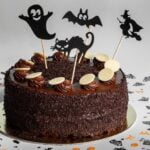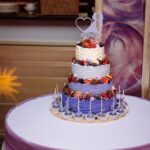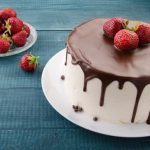Do you want to take your cake decorating skills to the next level? Look no further than the art of chocolate decorations. While frosting and fondant can create beautiful designs, there’s something special about adding a touch of edible elegance with chocolate. Whether you’re a beginner or an experienced baker, this guide will teach you everything you need to know about creating stunning chocolate decorations for cakes.
In this article, we will dive into the world of chocolate decorations, exploring essential tools and ingredients and providing step-by-step instructions for beginners as well as advanced techniques for those looking to push their limits. We’ll also cover troubleshooting and tips for common challenges that may arise along the way.
But first, let’s talk basics. To get started with making chocolate decorations, you’ll need a few key tools and ingredients. From melting chocolate properly to achieving the perfect consistency, understanding these basics is crucial for success. With the right knowledge and techniques at your disposal, you’ll be able to create intricate designs that will elevate any cake from ordinary to extraordinary.
So dust off your pastry brush and prepare to embark on a delectable journey through the sweet art of chocolate decorations for cakes. Get ready to impress your guests with visually stunning creations that are not only delicious but also a feast for the eyes. From simple shapes to intricate patterns, let’s master this edible art form together.
Understanding the Basics
When it comes to making chocolate decorations for cakes, having the right tools and ingredients is essential. Here, we will discuss the basic equipment and ingredients that you will need to get started on your chocolate decorating journey.
Essential Tools
To begin, you will need a few key tools that are specifically designed for working with chocolate. These include:
- Silicone molds: Silicone molds come in various shapes and sizes, allowing you to create intricate designs for your cake decorations. Look for molds that are flexible and easy to clean.
- Piping bags and tips: Piping bags are crucial for creating delicate details on your chocolate decorations. Make sure to have a variety of piping tips on hand to achieve different patterns and textures.
- Offset spatula: An offset spatula is useful for spreading melted chocolate onto flat surfaces or leveling out your decorations.
- Pallet knife: A pallet knife is perfect for lifting delicate chocolate decorations from silicone molds without damaging them.
- Cooling racks: Cooling racks allow your chocolate creations to set properly by allowing air circulation, ensuring a smooth finish.
- Scissors or craft knife: These tools are handy when trimming any excess chocolate from your finished designs or when cutting parchment paper into desired shapes.
Essential Ingredients
Apart from the necessary tools, you’ll also need high-quality ingredients to make delicious chocolate decorations:
- Chocolate: Opt for good quality cooking or baking chocolate that has at least 70% cocoa content for best results. You can choose between dark, milk, or white variations depending on the desired flavor and color of your decoration.
- Cocoa butter (optional): If you want to experiment with different colors or add shine to your designs, cocoa butter can be added to melted chocolate before shaping it into decorations.
- Food coloring (optional): Food coloring gels or powders can be used to add vibrant colors to your chocolate decorations. Make sure to use oil-based food coloring specifically designed for use with chocolate.
- Flavored extracts (optional): If you want to infuse your decorations with flavors, consider using flavored extracts such as vanilla, peppermint, or orange. Just remember that a little goes a long way, so use them sparingly.
By having the essential tools and ingredients at your disposal, you are well-prepared to dive into the world of chocolate decorations for cakes. With these basics covered, let’s move on to the next step: preparing the perfect chocolate for decorations.
Getting Started
One of the most important steps in creating beautiful chocolate decorations for cakes is to start with perfectly prepared chocolate. In this section, we will explore the essential steps and techniques for preparing the perfect chocolate for your creations.
First and foremost, it is crucial to use high-quality chocolate for your decorations. Look for brands that have a high cocoa percentage (preferably over 70%) and avoid using compound chocolates or candy melts, as they do not have the same flavor and texture as real chocolate.
Before starting any melting process, always chop the chocolate into small, uniform pieces. This ensures that the chocolate melts evenly and reduces the risk of burning. Unevenly chopped chocolate can result in lumps or a grainy texture in your final decorations.
There are several methods for melting chocolate, including using a microwave, a double boiler, or a heatproof bowl set over simmering water. Whichever method you choose, it is essential to melt the chocolate slowly and gently to prevent it from scorching or seizing.
To further improve the texture and consistency of your melted chocolate, you can add cocoa butter or vegetable oil in small amounts. This helps to create smoother and more workable chocolate for decorations.
Once melted, be sure to remove any moisture from your utensils or bowls before working with the chocolate. Even small amounts of water can cause the melted chocolate to seize up and become unusable.
| Method | Description |
|---|---|
| Melting Chocolate | Melt slowly and gently over low heat or using a double boiler to prevent scorching or seizing. |
| Chopping Chocolate | Chop into small, uniform pieces for even melting and smooth texture in decorations. |
| Additives | Adding small amounts of cocoa butter or vegetable oil can improve the texture and workability of the melted chocolate. |
Mastering the Art of Tempering
Tempering chocolate is a crucial step in creating beautifully smooth and glossy chocolate decorations for your cakes. Tempering refers to the process of heating, cooling, and then reheating chocolate to specific temperatures in order to stabilize the chocolate’s cocoa butter crystals. This process ensures that the chocolate sets properly with a firm texture, a shiny appearance, and a pleasant snap when bitten into.
To master the art of tempering, you’ll need some essential tools such as a digital thermometer, a heatproof bowl, a spatula or scraper, and a double boiler or microwave. Additionally, you will need high-quality chocolate couverture or tempered chocolate disks which contain cocoa butter and have been pre-crystallized.
There are three main methods for tempering chocolate: the seeding method, the tabling method (marble slab), and the direct method using a microwave. The seeding method involves melting two-thirds of your chocolate until it reaches a temperature between 115°F and 120°F (46°C-49°C), then adding in finely chopped pieces of unmelted chocolate to reduce its temperature and encourage proper crystallization. This method is ideal for small quantities of chocolate.
The tabling method requires spreading melted chocolate onto a cool marble surface and working it continuously back and forth with a spatula until it cools down to around 80°F (27°C). Once this temperature is reached, it is reheated briefly to bring it up to 88°F (31°C), which is the ideal temperature for dark or semi-sweet chocolates.
The direct method using a microwave involves melting your chocolate in short bursts of low heat while stirring frequently. This method is quicker than traditional methods but requires extra caution to ensure that the chocolate does not overheat or burn.
Regardless of which tempering technique you choose, it’s important to monitor the temperatures closely using your digital thermometer. Remember that different types of chocolates require different temperature ranges for tempering, so make sure to adjust accordingly. With practice and patience, you will become proficient in the art of tempering and achieve perfectly smooth chocolate decorations for your cakes.
Creating Stunning Chocolate Designs
Choosing the Right Chocolate
When it comes to creating stunning chocolate designs for cakes, choosing the right type of chocolate is essential. Not all chocolates are created equal, and different types of chocolate have different melting points and flavors. For creating decorations, it is best to use couverture chocolate, which contains a higher percentage of cocoa butter and melts smoothly.
Couverture chocolates are known for their glossy finish and they are perfect for creating intricate designs. Additionally, you can experiment with flavored chocolates such as white chocolate or dark chocolate to add different dimensions to your cake decorations.
Melting Chocolate
Melting chocolate properly is another important aspect of creating stunning designs. There are a few methods you can use to melt your chocolate:
- Double Boiler Method: This method involves placing a heatproof bowl containing chopped chocolate over a saucepan of simmering water. Stir the chocolate continuously until it melts completely.
- Microwave Method: Chop the chocolate into small pieces and place them in a microwave-safe bowl. Microwave at 30-second intervals, stirring in between each interval until the chocolate is melted and smooth.
Regardless of the method you choose, be careful not to let any water come into contact with the chocolate as it will cause it to seize and become lumpy.
Utilizing Different Decorating Techniques
There are several techniques you can employ to create stunning chocolate designs on your cakes:
- Piping: Fill a piping bag fitted with a small round tip with melted chocolate and pipe intricate patterns or shapes onto parchment paper or acetate sheets.
- Drizzling: Use a spoon or a squeeze bottle to drizzle melted chocolate in artistic patterns over your cake surface.
- Molding: Pour melted chocolate into silicone molds in various shapes like flowers, hearts, or geometric patterns.
- Hand Painting: Use food-safe paint brushes to apply colored melted chocolate directly onto the cake surface.
- Transfer Sheets: Place transfer sheets with printed designs on top of melted chocolate. Once set, the design will transfer onto the chocolate, creating beautiful patterns.
Experiment with these techniques and combine them to create unique and visually stunning chocolate decorations for your cakes. Remember to practice and master each technique before attempting complex designs. With time and patience, you will be able to create professional-looking chocolate decorations that will impress your guests.
From Simple to Sophisticated
Creating chocolate decorations for cakes can seem intimidating, but with the right techniques and practice, anyone can create stunning designs. Whether you’re a beginner or an advanced decorator, this section will provide step-by-step instructions to help you master the art of chocolate decorations.
For beginners, start with simple designs such as chocolate curls or shards. Begin by melting high-quality chocolate in a microwave or double boiler until smooth. Pour the melted chocolate onto a parchment-lined baking sheet and spread it out evenly. Let it cool slightly before using a sharp knife or spatula to create curls or shards. Allow the decorations to harden completely before carefully transferring them onto your cake.
Once you’ve mastered the basics, it’s time to move on to more advanced decorations. Consider trying your hand at creating intricate chocolate flowers or molds. To make chocolate flowers, start by melting different colors of tempered chocolate and transferring them into small piping bags or squeeze bottles.
Pipe thin lines of chocolate onto acetate sheets in various petal shapes and freeze them until set. Once the petals are firm, assemble them into beautiful flowers on top of your cake.
If you’re feeling especially ambitious, try making molded chocolates using silicone molds. Start by tempering your desired type of chocolate and pouring it into the mold, making sure to tap out any air bubbles. Let the chocolates set in the refrigerator until firm before carefully removing them from the molds.
| Beginner Decorations | Advanced Decorations |
|---|---|
| Making simple curls or shards | Crafting intricate chocolate flowers |
| Starting with high-quality melted chocolate | Tempering different colors of chocolate |
| Cooling decorations completely before transferring them onto the cake | Piping thin lines of chocolate onto acetate sheets for petals |
Adding Flair and Flavors
When it comes to chocolate decorations for cakes, there is no limit to the creativity and fun you can have with colors, flavors, and textures. Adding flair to your chocolate decorations not only enhances the overall aesthetics of your cake but also adds a delightful surprise for your taste buds. Here are some exciting ways to experiment with colors, flavors, and textures in your chocolate creations:
1. Colors:
Get creative with colors by using natural food coloring or colored cocoa butter to add a vibrant touch to your chocolate decorations. You can make a rainbow of chocolates using different hues or create ombre effects by blending various shades together. Consider the theme or occasion for the cake to choose colors that complement it best.
2. Flavors:
Infuse additional flavors into your chocolate decorations by incorporating flavored extracts or oils. From classic choices like vanilla and almond to more unique options like orange zest or coconut extract, experimenting with flavors adds depth and complexity to your chocolate creations. You can even try mixing different flavor combinations for a truly unique taste experience.
3. Textures:
Texture plays a crucial role in making your chocolate decorations visually appealing and interesting. There are several ways you can add texture to your designs, such as using textured molds or adding edible elements like nuts, sprinkles, or crushed cookies to the melted chocolate before it sets. Additionally, you can create intriguing patterns by incorporating techniques like marbling or feathering.
As you explore these options for adding flair and flavors to your chocolate decorations, remember that experimentation is key. Don’t be afraid to think outside of the box and try new combinations – you may stumble upon an unexpected yet delightful flavor profile or design technique that becomes your signature style.
Taking the time to experiment with colors, flavors, and textures will elevate your cakes from ordinary to extraordinary. The addition of unique touches not only showcases your creativity but also adds a personalized and memorable touch to your chocolate decorations. So, let your imagination run wild and have fun exploring the endless possibilities that await you in the world of chocolate decoration.
Troubleshooting and Tips
Common Challenges in Making Chocolate Decorations
Making chocolate decorations for cakes can sometimes be a tricky process, and it’s not uncommon to encounter certain challenges along the way. However, with a little patience and the right knowledge, you can easily overcome these obstacles. Here are some common challenges that you may come across when making chocolate decorations for cakes:
Chocolate Seizing
One of the most common challenges when working with chocolate is experiencing “seizing,” which is when the chocolate suddenly becomes thick and grainy. This can happen if even a small amount of moisture comes into contact with the chocolate.
To prevent seizing, make sure all your equipment is completely dry before using it, as even a drop of water can ruin the texture of melted chocolate. If your chocolate seizes, however, you can try adding a tablespoon of vegetable oil or cocoa butter to help restore its smoothness.
Bloomed Chocolate
Another challenge you may face is “blooming” on your chocolate decorations, where white streaks or spots appear on the surface. This happens when the cocoa butter in the chocolate rises to the surface and recrystallizes due to changes in temperature or improper storage.
To avoid blooming, be sure to store your finished chocolate decorations in a cool, dry place away from direct sunlight. If blooming occurs, you can still use the decorations by scraping off any affected areas or gently reheating and smoothing out the surface.
Solutions and Tips for Chocolate Decoration-Making
Now that we have discussed some common challenges in making chocolate decorations for cakes, let’s explore some solutions and tips to help you navigate through these hurdles:
Use High-Quality Ingredients
Using high-quality ingredients is crucial when making chocolate decorations as it directly affects both taste and texture. Opt for finely crafted chocolate with a high percentage of cocoa solids to ensure the best results. Additionally, using fresh ingredients such as flavors or extracts can elevate the overall taste of your chocolate decorations.
Practice Proper Tempering Techniques
The key to perfectly smooth and glossy chocolate decorations lies in proper tempering. Take the time to learn and practice different tempering techniques, such as seeding or tabling, to achieve the desired results. Remember to use a reliable thermometer and be patient during the tempering process, as rushing can lead to inconsistent results.
Be Mindful of Room Temperature and Humidity
Room temperature and humidity can significantly affect the outcome of your chocolate decorations. Ideally, work in a cool room with low humidity, as higher temperatures and moisture can cause the chocolate to melt too quickly or seize. If you’re working in a warm environment, consider using an air-conditioned space or placing a portable fan nearby to control the temperature.
By being aware of common challenges and applying these solutions and tips, you’ll be better equipped to troubleshoot any issues that may arise while making chocolate decorations for cakes. Remember that practice makes perfect, so don’t hesitate to experiment and refine your techniques along the way. With dedication and patience, you’ll soon be creating stunning and delicious chocolate decorations that will impress your guests.
Wow Your Guests
When it comes to chocolate decorations for cakes, there are endless possibilities for you to explore and experiment with. To truly wow your guests, you can go beyond the traditional designs and add a unique touch to your creations. Here are some innovative ideas and inspirations that will take your chocolate decorated cakes to the next level:
Geometric Designs
Instead of sticking to the usual swirls and curls, why not try creating geometric patterns with chocolate? Think squares, triangles, or even abstract shapes. Use a piping bag fitted with a small round tip to pipe the melted chocolate onto wax paper in various shapes and sizes. Once hardened, carefully peel them off and arrange them on top of your cake for a modern and visually striking effect.
Nature-Inspired Decorations
Nature provides us with beautiful forms that can serve as inspiration for our chocolate decorations. Consider making delicate chocolate leaves by painting melted chocolate onto real leaves and allowing it to harden before gently peeling the leaf away. You can also create realistic-looking flowers using molds or by hand-piping petals and assembling them together.
Mirror Glaze
Mirror glaze is a technique that involves pouring a shiny glaze over the cake, giving it a highly reflective finish. To achieve this effect, make sure your cake is smooth and chilled before pouring the glaze over it. The glaze is made from a combination of gelatin, sugar syrup, condensed milk, and white chocolate. Experiment with different colors for an eye-catching result.
Texture Play
Explore different textures by incorporating various ingredients into your chocolate decorations. Crushed nuts, cookie crumbs or even dried fruit can be mixed into melted chocolate before spreading it thinly on parchment paper or silicone mats. Once hardened, break them up into uneven shapes and use them to add texture and crunch to your cake design.
Remember, the key to achieving innovative chocolate decorations is to let your creativity flow. Don’t be afraid to experiment with different techniques, colors, and flavors. The more you play around with chocolate, the more unique and impressive your creations will become.
The Finishing Touch
Once you have carefully crafted your beautiful chocolate decorations for cakes, it is important to know how to store and preserve them properly. By taking the necessary steps to protect your creations, you can ensure that they stay in perfect condition until it is time to adorn your cake with them.
Storing chocolate decorations requires a cool and dry environment. Excessive humidity and heat can cause the chocolate to melt or lose its shape. It is best to store them in an airtight container or a sealable plastic bag before placing them in the refrigerator. Make sure to separate different designs with wax paper or parchment paper to prevent them from sticking together.
When it comes to preserving your handmade chocolate decorations, timing is key. The sooner you place them on your cake, the better they will look. This is because over time, the chocolate may start to lose its shine and become dull due to exposure to air and moisture. If you need to store them for more than a day, consider using an edible varnish spray specifically designed for chocolate decorations, as it can help extend their shelf life.
| Type of Chocolate Decoration | Expected Shelf Life |
|---|---|
| Molded or piped chocolate shapes | 1-2 weeks |
| Chocolate curls or shavings | Several months when frozen |
| Chocolate transfers or prints | Up to 6 months when stored in a cool place away from direct sunlight |
By properly storing and preserving your homemade chocolate decorations, you can confidently prepare them in advance and wow your guests with beautifully adorned cakes whenever the occasion arises. So go ahead, take the time to create stunning chocolate designs and elevate your cake game.
Conclusion
In conclusion, mastering the art of chocolate decorations for cakes can truly elevate your cake game and impress your guests. By understanding the basics, such as the essential tools and ingredients needed, and by properly preparing and tempering the chocolate, you can achieve perfectly smooth and stunning designs.
With a variety of techniques and tips at your disposal, you can create a wide range of chocolate designs, from simple to sophisticated. Whether you are a beginner or more advanced in your cake decorating skills, step-by-step instructions are provided to guide you through the process.
Don’t be afraid to experiment with colors, flavors, and textures to add flair to your chocolate decorations. This allows for even more creativity and customization in your cake designs. Additionally, troubleshooting tips are provided to help overcome common challenges that may arise during the decoration process.
Finally, by storing and preserving your chocolate decorations properly, you can ensure that they stay fresh and intact until it’s time to wow your guests with your beautifully adorned cakes. So why not take your cake game to the next level by incorporating homemade chocolate decorations? With practice and creativity, you’ll soon be able to create stunning masterpieces that will leave everyone in awe.

Welcome to my blog about home and family. This blog is a place where I will share my thoughts, ideas, and experiences related to these important topics. I am a stay-at-home mom with two young children. I hope you enjoy reading it! and may find some helpful tips and ideas that will make your home and family life even better!





